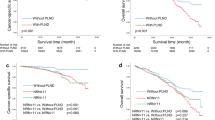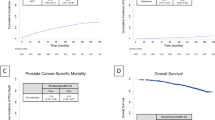Abstract
Background:
The therapeutic effect of pelvic lymph node dissection (PLND) during radical prostatectomy (RP) due to prostate cancer (PCa) is still under debate. We aimed at assessing the impact of more extensive PLND on cancer-specific mortality (CSM) in patients treated with surgery for locally advanced PCa.
Methods:
We examined data of 1586 pT3-T4 PCa patients treated with RP and extended PLND between 1987 and 2012 at a tertiary referral care center. Univariable and multivariable Cox regression analyses tested the relationship between the number of nodes removed and CSM rate, after adjusting for potential confounders. Survival estimates were based on the multivariable models.
Results:
The average number of nodes removed was 19 (median: 17; interquartile range: 11–23). Mean and median follow-up were 80 and 72 months, respectively. At multivariable analyses, Gleason score 8–10 (hazard ratio (HR): 2.5) and a higher number of positive nodes (HR: 1.06) were independently associated with higher CSM rate (all P<0.05). Conversely, higher number of removed LNs (HR: 0.94) and adjuvant radiotherapy (HR: 0.54) were independent predictors of lower CSM rates (all P⩽0.03).
Conclusions:
In pT3-T4 PCa patients, removal of a higher number of LNs during RP was associated with higher cancer-specific survival rates. This supports the role of more extensive PLNDs in this patient group. Further prospective studies are needed to validate our findings.
This is a preview of subscription content, access via your institution
Access options
Subscribe to this journal
Receive 4 print issues and online access
$259.00 per year
only $64.75 per issue
Buy this article
- Purchase on Springer Link
- Instant access to full article PDF
Prices may be subject to local taxes which are calculated during checkout


Similar content being viewed by others
References
Siegel R, Ma J, Zou Z, Jemal A . Cancer statistics, 2014. CA Cancer J Clin 2014; 64: 9–29.
Noldus J, Graefen M, Haese A, Henke RP, Hammerer P, Huland H . Stage migration in clinically localized prostate cancer. Eur Urol 2000; 38: 74–78.
Cooperberg MR, Moul JW, Carroll PR . The changing face of prostate cancer. J Clin Oncol 2005; 23: 8146–8151.
Cooperberg MR, Broering JM, Carroll PR . Time trends and local variation in primary treatment of localized prostate cancer. J Clin Oncol 2010; 28: 1117–1123.
Moschini M, Sharma V, Zattoni F, Quevedo JF, Davis BJ, Kwon E et al. Natural history of clinical recurrence patterns of lymph node-positive prostate cancer after radical prostatectomy. Eur Urol 2015 (doi:10.1016/j.eururo.2015.03.036; e-pub ahead of print).
Bolla M, van Poppel H, Tombal B, Vekemans K, Da Pozzo L, de Reijke TM et al. Postoperative radiotherapy after radical prostatectomy for high-risk prostate cancer: long-term results of a randomised controlled trial (EORTC trial 22911). Lancet 2012; 380: 2018–2027.
Wiegel T, Bottke D, Steiner U, Siegmann A, Golz R, Störkel S et al. Phase III postoperative adjuvant radiotherapy after radical prostatectomy compared with radical prostatectomy alone in pT3 prostate cancer with postoperative undetectable prostate-specific antigen: ARO 96-02/AUO AP 09/95. J Clin Oncol 2009; 27: 2924–2930.
Thompson IM, Tangen CM, Paradelo J, Lucia MS, Miller G, Troyer D et al. Adjuvant radiotherapy for pathological T3N0M0 prostate cancer significantly reduces risk of metastases and improves survival: long-term followup of a randomized clinical trial. J Urol 2009; 181: 956–962.
Briganti A, Larcher A, Abdollah F, Capitanio U, Gallina A, Suardi N et al. Updated nomogram predicting lymph node invasion in patients with prostate cancer undergoing extended pelvic lymph node dissection: the essential importance of percentage of positive cores. Eur Urol 2012; 61: 480–487.
Pagliarulo V, Hawes D, Brands FH, Groshen S, Cai J, Stein JP et al. Detection of occult lymph node metastases in locally advanced node-negative prostate cancer. J Clin Oncol 2006; 24: 2735–2742.
Abdollah F, Gandaglia G, Suardi N, Capitanio U, Salonia A, Nini A et al. More extensive pelvic lymph node dissection improves survival in patients with node-positive prostate cancer. Eur Urol 2014; 67: 1–8.
Abdollah F, Suardi N, Gallina A, Bianchi M, Tutolo M, Passoni N et al. Extended pelvic lymph node dissection in prostate cancer: a 20-year audit in a single center. Ann Oncol 2013; 24: 1459–1466.
Cozzarini C, Montorsi F, Fiorino C, Alongi F, Bolognesi A, Da Pozzo LF et al. Need for high radiation dose (>or=70 gy) in early postoperative irradiation after radical prostatectomy: a single-institution analysis of 334 high-risk, node-negative patients. Int J Radiat Oncol Biol Phys 2009; 75: 966–974.
Schiavina R, Manferrari F, Garofalo M, Bertaccini A, Vagnoni V, Guidi M et al. The extent of pelvic lymph node dissection correlates with the biochemical recurrence rate in patients with intermediate- and high-risk prostate cancer. BJU Int 2011; 108: 1262–1268.
Albertsen PC, Hanley JA, Barrows GH, Penson DF, Kowalczyk PDH, Sanders MM et al. Prostate cancer and the Will Rogers phenomenon. J Natl Cancer Inst 2005; 97: 1248–1253.
Joslyn SA, Konety BR . Impact of extent of lymphadenectomy on survival after radical prostatectomy for prostate cancer. Urology 2006; 68: 121–125.
Murphy AM, Berkman DS, Desai M, Benson MC, McKiernan JM, Badani KK . The number of negative pelvic lymph nodes removed does not affect the risk of biochemical failure after radical prostatectomy. BJU Int 2010; 105: 176–179.
Masterson TA, Bianco FJ, Vickers AJ, DiBlasio CJ, Fearn PA, Rabbani F et al. The association between total and positive lymph node counts, and disease progression in clinically localized prostate cancer. J Urol 2006; 175: 1320–1324; discussion 1324–1325.
Bivalacqua TJ, Pierorazio PM, Gorin MA, Allaf ME, Carter HB, Walsh PC . Anatomic extent of pelvic lymph node dissection: impact on long-term cancer-specific outcomes in men with positive lymph nodes at time of radical prostatectomy. Urology 2013; 82: 653–658.
DiMarco DS, Zincke H, Sebo TJ, Slezak J, Bergstralh EJ, Blute ML . The extent of lymphadenectomy for pTXNO prostate cancer does not affect prostate cancer outcome in the prostate specific antigen era. J Urol 2005; 173: 1121–1125.
Touijer KA, Mazzola CR, Sjoberg DD, Scardino PT, Eastham JA . Long-term outcomes of patients with lymph node metastasis treated with radical prostatectomy without adjuvant androgen-deprivation therapy. Eur Urol 2014; 65: 20–25.
Pierorazio PM, Gorin MA, Ross AE, Feng Z, Trock BJ, Schaeffer EM et al. Pathological and oncologic outcomes for men with positive lymph nodes at radical prostatectomy: the Johns Hopkins hospital 30-year experience. Prostate 2013; 73: 1673–1680.
Heidenreich A, Varga Z, Von Knobloch R . Extended pelvic lymphadenectomy in patients undergoing radical prostatectomy: high incidence of lymph node metastasis. J Urol 2002; 167: 1681–1686.
Joniau S, Van den Bergh L, Lerut E, Deroose CM, Haustermans K, Oyen R et al. Mapping of pelvic lymph node metastases in prostate cancer. Eur Urol 2013; 63: 450–458.
De Rooij M, Hamoen EHJ, Witjes JA, Barentsz JO, Rovers MM . Accuracy of magnetic resonance imaging for local staging of prostate cancer: a diagnostic meta-analysis. Eur Urol 2015 (doi:10.1016/j.eururo.2015.07.029; e-pub ahead of print).
Muralidhar V, Dinh KT, Mahal BA, Ziehr DR, Chen Y-W, Viswanathan VB et al. Differential post-prostatectomy cancer-specific survival of occult T3 vs clinical T3 prostate cancer: Implications for managing patients upstaged on prostate magnetic resonance imaging. Urol Oncol 2015; 33: 330.e19–e25.
Thompson IM, Tangen CM, Paradelo J, Lucia MS, Miller G, Troyer D et al. Adjuvant radiotherapy for pathologically advanced prostate cancer: a randomized clinical trial. JAMA 2006; 296: 2329–2335.
Author information
Authors and Affiliations
Corresponding author
Ethics declarations
Competing interests
The authors declare no conflict of interest.
Rights and permissions
About this article
Cite this article
Moschini, M., Fossati, N., Abdollah, F. et al. Determinants of long-term survival of patients with locally advanced prostate cancer: the role of extensive pelvic lymph node dissection. Prostate Cancer Prostatic Dis 19, 63–67 (2016). https://doi.org/10.1038/pcan.2015.51
Received:
Revised:
Accepted:
Published:
Issue Date:
DOI: https://doi.org/10.1038/pcan.2015.51
This article is cited by
-
The role of cystoprostatectomy in management of locally advanced prostate cancer: a systematic review
World Journal of Surgical Oncology (2020)
-
Effect of the number of removed lymph nodes on prostate cancer recurrence and survival: evidence from an observational study
BMC Bioinformatics (2018)
-
The impact of local treatment of the primary tumor site in node positive and metastatic prostate cancer patients
Prostate Cancer and Prostatic Diseases (2017)
-
The role of salvage extended lymph node dissection in patients with rising PSA and PET/CT scan detected nodal recurrence of prostate cancer
Prostate Cancer and Prostatic Diseases (2017)
-
Therapeutic Value of Standard Versus Extended Pelvic Lymph Node Dissection During Radical Prostatectomy for High-Risk Prostate Cancer
Current Urology Reports (2017)



